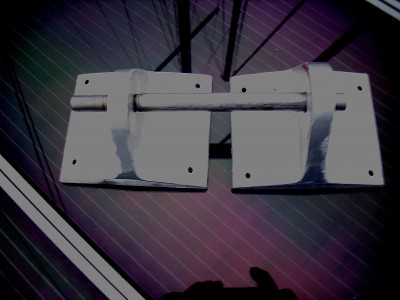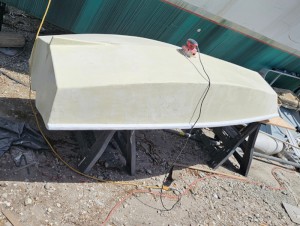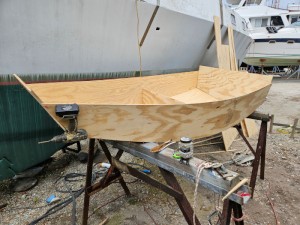Kaimusailing
s/v Kaimu Wharram Catamaran
| Vessel Name: | Kaimu |
| Vessel Make/Model: | Wharram Custom |
| Hailing Port: | Norwalk, CT |
| Crew: | Andy and the Kaimu Crew |
| About: | Sailors in the Baltimore, Annapolis, DC area. |
17 April 2024 | St Marys, GA
Dinghy Skeg
I was suffering with what seemed like a cold and also had allergy symptoms. I awoke and felt fine. The green pollen that was coating everything was gone. Maybe it will return.
07 April 2024 | St. Marys, GA
Clammy Hands
Items came in from TEMU, the Chinese cut rate retailer. One was a nice little drone that cost about twelve and a half dollars. It looked like an easy thing to play with while I coughed and sneezed. I was fighting a summer cold, even though it is not summer elsewhere, it seems like it here. A nice [...]
02 April 2024 | St. Marys, GA
Sun Doggie
After laminating the cedar strips onto the gunwales of the dinghy I found the screws I used wouldn’t come out. The epoxy had seized them. The screw heads were stripped so I cut a straight slot in the heads with the cut off wheel. The cedar smoked when the screw heads got red hot. I could remove [...]
21 March 2024 | St. Marys, GA
Just Add Water
The rainy weekend started off with overcast and fog but no rain. It looked like I might be able to get something done on the D4 dinghy. I wanted to change the bow seat which is really the bow deck. The sailing option uses the deck to hold the freestanding mast. I didn’t like how the deck looked, [...]
01 March 2024 | St. Marys, GA
D4 Dinghy Alternative Seats
The rain event was more wind than rain, strong winds with gusts up to 44 mph. We drove into town to see what the harbor was like. There was a small sailboat that had dragged anchor and was sitting close to shore. The tide was out. We left and played with Bleu at Notter’s Pond.
23 February 2024 | St. Marys, GA
D4 Inside Seams
Day two of the dinghy build started out with me finishing wiring the hull bottoms together on the centerline of the bottom panels. This was much easier than the wiring of the chine edges of the bottom panels and the side panels.
Sprung has Spring

Then in the space of about 2 weeks, the weather pattern shifted. Instead of record breaking below average temperatures, record highs melted the snow and ice.
A warm weekend enabled me to uncover the dinghies and repair damage of the winter. They had been blown off the dock by high winds more than once. Repairs on Saturday, rowing on Sunday. Dinghy #2 was fine and I rowed up to the marina, cautiously due to the low water temperature. Dinghy #1 had its seat come loose and only got about 50 feet from the dock. It was repaired with epoxy to be tested the following weekend. Then it had a leak and needed another repair.
I could see damage to the catamaran's decks due to ice. The good weather continued for several weekends and I painted the cabin tops and decks after repairing them. It looked like we were back on track for the season.
One remaining potential problem from the 2002 winter storm passage was the broken boom gooseneck. It had been repaired, but I could see the fitting might fail again in heavy conditions. I took a leftover piece of aluminum I-beam from last year's beam repair and cut out hefty fittings for a new gooseneck. After shaping them and conversion coating, I took a picture of them for this blog post.
Painting is a good time to inspect the surfaces to be painted and look for any problems with bedded fittings, crazing, cracking, checking, and other signs of deterioration. Painting also demands that the surfaces be cleaned and scraped.
When I was working around the main traveler track, I noticed the double turning blocks at each end of the traveler. They were now unused, since I had converted from windward sheeting to the simpler center main traveler control. The windward sheeting setup pulls on the traveler car from the windward end of the traveler. This allows the traveler car to be positioned to windward of the centerline of the boat. The mainsail can then be brought in closer, more "close hauled". The drawback is the design includes at least a 4:1 purchase. In other words, to move the traveler car one foot, four feet of line needs to be hauled. The traveler is 18 feet long. When sailing off the wind, up to 18 X 4 feet of line needs to be let out. Yes, that's at least 70 feet of line on each end of the traveler. Later I learned of a recommendation by the manufacturer to splice the ends of the traveler control lines together so that the line spooled off one end gets pulled into the other end.
Catamarans sail differently than most single hulled boats. Higher speeds make windward sailing more a technique of maintaining high boat speed while reducing drag and the leeward component of sail drive. The windward sheeting method tends to increase the leeward component while not adding anything to the forward drive component. A single hulled boat is carrying a lot of lead ballast, so it is always sailing in "displacement" mode, which means it is limited in hull speed to about 5/4 sq rt waterline length, in knots. Windward sheeting allows pointing closer to the wind, and that is the advantage to boats that can't go much faster.
On a catamaran the pointing toward the wind is secondary to how fast the boat is going. It's like taking the expressway a longer distance to save time over a direct local road that is slower. I don't like windward sheeting and prefer to keep the mainsail trimmed such that the leech is open and not cupped to windward. I like the leech of the sail to be parallel to our course. Also, this allows the traveler control to operate from the centerline. This method allows the traveler car to be let out from the center of the traveler track. The distance to the end of the track is 9 feet. The amount of line needed is only 36 ft. Another advantage is the line doesn't have to be hauled in on each tack, when the boat tacks, the car simply runs out to the other side an equal distance as the previous tack.
So there were those double turning blocks sitting there unused. I could use them on the
genoa travelers. The genoa traveler cars tend to always try to move aft, so control is as simple as tying them off at the optimum position. Adjustment is made on the lazy genoa track so that it is correct on the next tack, then the new lazy track can be adjusted. The problem with this arrangement is it is difficult to adjust the track while it is in use. If I put the double turning blocks at the fore end of the genoa tracks, I can set up a 4:1 or 5:1 purchase so that the traveler car can be brought forward under tension when in use. This would allow adjustment while watching how the sail is drawing. A great improvement.
And now a brief advertisement for a product know as UV6800, available from McMaster-Carr. This is similar to "marine goop". It is like silicone sealant, but is urethane and very strong after it sets up. It can be used to glue fabric together, because it is very flexible, and it can be used to bed fittings, because it is strong and permeates and seals.
I removed the turning blocks from the starboard end of the traveler after returning to the cottage to get a thin wall socket. On the port end of the traveler it wasn't so easy. Beam covers surround the traveler track, but on the port end they prevent the blocks from sliding off the track. The covers had to come off. I didn't have the correct socket to remove the screws, so a metric wrench, almost the same size was used. It would have been better to return to the cottage to get the correct socket, but the day was becoming overcast and rain was in the forecast. Work continued at an accelerated pace. The screws were out of the covers, but they didn't budge. Finally a pry bar released them with sounds of crunching wood. UV6800 was showing its strength. The covers had been bedded with the stuff and the underlying finish and some wood came off with them.
The turning blocks are made with roller bearings. I found this out when I began disassembling the port block to remove it in parts. Something disappeared into the beam trough after the cover was removed and the block was disassembled. There was a mess in the trough, old leaves, catkins, maple helicopters, bird feathers, and somewhere in there was a part for the turning block. I removed the rest of the parts to a tray and sorted them out. The two block sheaves had two races apiece. The only missing part must be one of the rollers. I counted them out and found 47 rollers. There must be 12 per race and one of them must be the missing part. I found it and reassembled the block.
The impending rain spurred me on to consider the next step of the process. Putting the blocks on the ends of the genoa tracks. However they could not go on, the hatch edges were in the way. The only way to get them on was to remove the genoa tracks. I counted the bolts. 14. In each track. The bolt heads were on deck and the nuts were down below in the cabin. Fortunately all but one nut came off without asking for help to hold the bolt head on deck. Once again, they were sealed with UV6800. The one that spun freely needed one end secured somehow. I tried vice gripping the head, but it wouldn't hold. I put the vice grip on the nut down below and tied a line on the handle of the vice grip and secured the line on a clamp on the hatch coaming. Now with the bolts removed, the tracks could be removed. They didn't budge. I forced an old knife under one end of the track and then forced it along the track. Once again UV6800 was used to bed the tracks. The deck under the track was a mess of bedding and half peeled paint. Fortunately I found a 7" flap disk while climbing in the cabin to work on the nuts. A quick grinding job on the deck prepared it for reinstallation of the tracks.
It was getting darker by the minute and there were spits of rain now and then. I used the knife to scrape old bedding compound from the tracks. A new tube of UV6800 was pierced and slapped into the caulking gun. The deck was caulked, the tracks were put down, and the bolt holes were caulked. A bit was used in the 1/2" drill to screw the bolts in. Tools were stowed and the boat was closed up. The rain however, didn't materialize.






